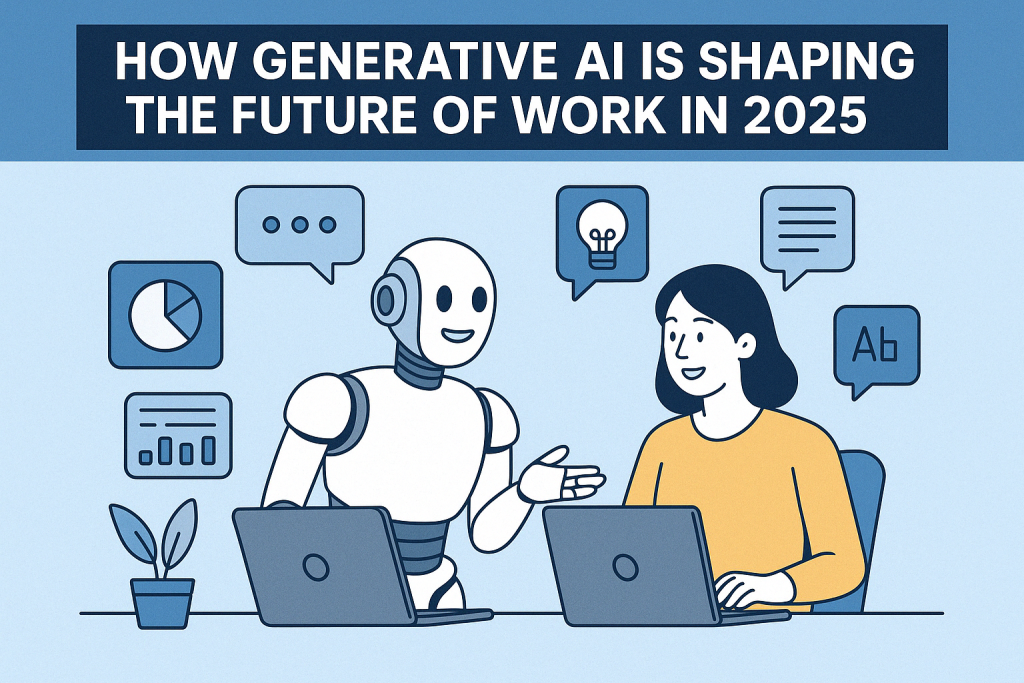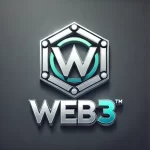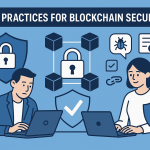📌 Introduction: The Work Meeting That Wasn’t Human
It’s Monday morning. You log into a project dashboard, and your AI assistant has already summarized your clients’ feedback, drafted an email reply, and scheduled a brainstorming session — all while you were asleep.
This isn’t the future. It’s already happening.
Generative AI tools like ChatGPT, Claude, and GitHub Copilot are radically transforming how we work, collaborate, and even think. In 2025, they are no longer just tools — they are digital coworkers. This article explores how generative AI is shaping the future of work, what this means for businesses and individuals, and what we must do to thrive in this evolving landscape.

🤖 What Is Generative AI?
Generative AI refers to artificial intelligence models that can generate new content, such as:
- Text (e.g., blog posts, reports, emails)
- Code (e.g., software, scripts, automation)
- Images (e.g., DALL·E)
- Audio (e.g., AI voiceovers)
- Video (e.g., synthetic actors, demo reels)
Unlike traditional AI that classifies or predicts based on existing data, generative models create. They rely on large-scale models (LLMs, diffusion models, transformers) trained on massive datasets to simulate human-like outputs.
In the workplace, this capability translates to amplified productivity and creativity.
📊 The Numbers Don’t Lie
Here’s what’s already happening in 2025:
| Sector | AI Usage Growth (YoY) | Common Use Cases |
|---|---|---|
| Marketing | +67% | Content drafting, A/B testing, SEO writing |
| Software Dev | +54% | Code generation, bug detection |
| Customer Support | +82% | AI chatbots, email summaries |
| Legal | +39% | Contract reviews, legal research |
| HR / Recruiting | +48% | Resume screening, job description drafting |
(Source: McKinsey, OpenAI Enterprise Report 2025)
⚙️ How Generative AI Is Redefining Work
1. 📩 Content Generation
Writers, marketers, and analysts are using AI to generate outlines, summaries, and even full articles. Instead of starting from scratch, humans now review and refine AI drafts.
2. 💻 Coding Assistance
Developers use tools like GitHub Copilot to autocomplete code, explain unfamiliar libraries, and convert natural language into functional code — reducing development time dramatically.
3. 📞 Automated Support & Outreach
Customer service has evolved. AI bots now respond contextually, learn from past queries, and even detect user emotion through text — leading to better satisfaction scores.
4. 🧠 Strategic Decision Support
Executives are leveraging AI to simulate business scenarios, conduct risk assessments, and generate insights from complex data.
5. 🎨 Creative Collaboration
Designers use Midjourney or DALL·E to brainstorm concepts and iterate ideas. AI isn’t replacing creativity — it’s speeding up experimentation.
⚖️ Challenges and Considerations
| Opportunity | Risk |
|---|---|
| Boosts productivity & innovation | Over-reliance and skill atrophy |
| Lowers barriers to content creation | Misinformation and factual hallucinations |
| Democratizes expertise and access | Ethical concerns & data privacy |
| Enhances employee augmentation | Job role ambiguity and organizational shifts |
While generative AI won’t replace humans, humans using AI will replace those who don’t.
🛠️ Practical Tools Shaping 2025 Workflows
| Tool | Use Case |
|---|---|
| ChatGPT-5 | Writing, research, email |
| Claude 3 | Business documents, contracts |
| Copilot X | Coding, debugging, testing |
| DALL·E 3 | Visual brainstorming |
| Jasper | Marketing content, ad copy |
| Gamma | AI-powered slide decks |
🔮 Future of Work: Co-Creation, Not Replacement
The narrative isn’t “AI vs. jobs.” It’s “AI with jobs.”
The workplace is moving toward human-AI collaboration, where your role is to ask better questions, validate outputs, and bring critical thinking, empathy, and ethics — the things AI still can’t do.
❓ FAQs: Generative AI in the Workplace
- Will generative AI take my job?
AI may automate routine tasks, but it also creates new roles that require human oversight, creativity, and strategy. - How can I stay relevant in an AI-powered workplace?
Upskill in prompt engineering, data literacy, and AI ethics. Adaptability and learning are the top skills. - Can I trust AI-generated content?
Not always. Human review is critical, especially in legal, medical, or public-facing content. - Is AI only for tech workers?
No. Educators, marketers, HR professionals, and even healthcare workers are integrating generative AI into daily workflows. - How do I start using AI tools?
Begin with free tools like ChatGPT or Jasper. Experiment, take courses, and follow real-world use cases.
✅ Final Thoughts: Adapt, Don’t Panic
Generative AI is not a threat — it’s a tool. But like any tool, its power lies in how you use it.
If you’re a creator, become a curator.
If you’re a manager, become a strategist.
If you’re an employee, become an innovator.
The future of work is not AI replacing people — it’s AI augmenting people who are ready.
👉 What’s Next?
- Try using ChatGPT for your next email draft
- Explore GitHub Copilot if you code
- Subscribe to WebIII3.com for more AI-powered work guides

